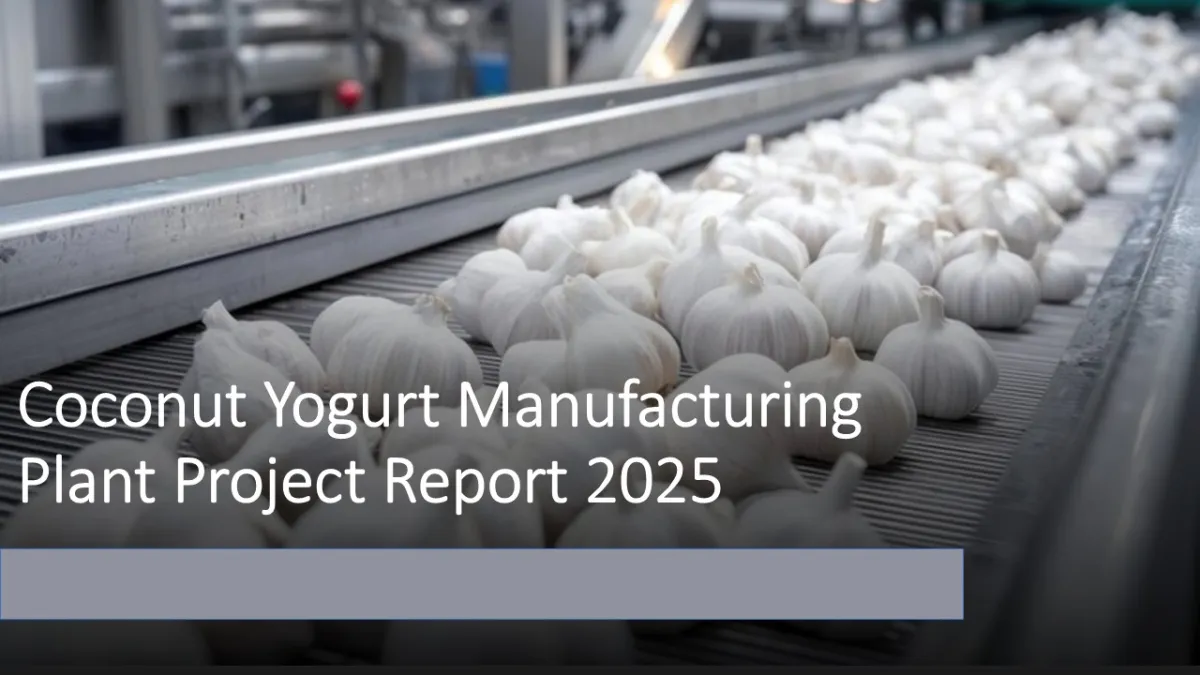
Guide To Garlic Powder Manufacturing Plant: Market Trends, Setup Costs, And ROI 2025
Setting up a garlic powder manufacturing plant involves sourcing high-quality garlic, establishing processing facilities for cleaning, drying, grinding, and packaging, and ensuring compliance with food safety standards. Efficient machinery, hygienic production practices, and effective distribution channels are critical for profitability and scalability.
IMARC Group's report, titled “ Garlic Powder Manufacturing Plant Project Report 2025: Industry Trends, Plant Setup, Machinery, Raw Materials, Investment Opportunities, Cost and Revenue,” provides a complete roadmap for setting up a garlic powder manufacturing plant. It covers a comprehensive market overview to micro-level information such as unit operations involved, raw material requirements, utility requirements, infrastructure requirements, machinery and technology requirements, manpower requirements, packaging requirements, transportation requirements, etc.
Request for a Sample Report : https://www.imarcgroup.com/garlic-powder-manufacturing-plant-project-report/requestsample
Garlic Powder Industry outlook 2025:
The garlic powder industry outlook for 2025 reflects strong growth driven by rising demand in the food processing, hospitality, and packaged food sectors. Increasing consumer preference for convenient and long-lasting seasonings, coupled with expanding applications in sauces, snacks, instant meals, and ready-to-eat products, is fueling market expansion. Health benefits associated with garlic, including its antimicrobial and antioxidant properties, further enhance its appeal in nutraceuticals and dietary supplements. Emerging markets in Asia-Pacific and Africa are expected to witness significant growth due to rising urbanization and changing dietary habits, while technological advancements in dehydration and packaging continue to improve efficiency and quality.
Key Insights for Garlic Powder Manufacturing Plant Setup:
Detailed Process Flow:
-
Product Overview
Unit Operations Involved
Mass Balance and Raw Material Requirements
Quality Assurance Criteria
Technical Tests
Project Details, Requirements and Costs Involved:
-
Land, Location and Site Development
Plant Layout
Machinery Requirements and Costs
Raw Material Requirements and Costs
Packaging Requirements and Costs
Transportation Requirements and Costs
Utility Requirements and Costs
Human Resource Requirements and Costs
Capital Expenditure (CapEx) and Operational Expenditure (OpEx) Analysis:
Project Economics:
-
Capital Investments
Operating Costs
Expenditure Projections
Revenue Projections
Taxation and Depreciation
Profit Projections
Financial Analysis
Profitability Analysis:
-
Total Income
Total Expenditure
Gross Profit
Gross Margin
Net Profit
Net Margin
Key Cost Components of Setting Up a Garlic Powder Plant :
-
Raw Material Procurement: Cost of sourcing high-quality garlic bulbs for continuous production.
Land and Infrastructure: Expenses related to land acquisition, construction of processing units, storage, and utilities.
Machinery and Equipment: Investment in cleaning, peeling, drying, grinding, and packaging machinery.
Labor and Workforce: Wages for skilled and unskilled labor, supervisors, and technical staff.
Utilities and Energy: Electricity, water supply, fuel, and waste management systems.
Packaging and Labeling: Materials and machinery for hygienic packaging and branding.
Compliance and Certification: Costs of meeting food safety standards and obtaining licenses.
Marketing and Distribution: Branding, logistics, and supply chain expenses for market reach.
Economic Trends Influencing Garlic Powder Plant Setup Costs 2025 :
-
Rising Raw Material Prices: Fluctuations in garlic cultivation costs due to weather, input prices, and global supply-demand dynamics.
Energy and Utility Costs: Increasing electricity and fuel rates directly impacting processing and drying expenses.
Labor Market Shifts: Wage growth and skilled labor shortages in food processing affecting operational budgets.
Technological Advancements: Adoption of modern dehydration and automation equipment reducing long-term costs but requiring higher initial investment.
Global Trade Policies: Import-export regulations, tariffs, and logistics costs shaping raw material sourcing and market access.
Inflationary Pressures: General inflation raising expenses across infrastructure, packaging, and distribution.
Speak to an Analyst for Customized Report: https://www.imarcgroup.com/request?type=report&id=7428&flag=E
Challenges and Considerations for Investors in Garlic Powder Plant Projects:
-
Raw Material Dependency: Seasonal fluctuations in garlic availability and price volatility impacting production stability.
Quality Control: Maintaining consistent flavor, color, and hygiene standards to meet food safety regulations.
High Initial Capital: Significant upfront investment in land, machinery, and infrastructure.
Market Competition: Intense competition from established spice manufacturers and low-cost regional producers.
Supply Chain Risks: Transportation, storage, and distribution challenges affecting timely delivery.
Regulatory Compliance: Stringent food safety certifications, labeling requirements, and environmental regulations.
Consumer Preferences: Shifts toward organic, chemical-free, and sustainably sourced garlic products.
Global Trade Dynamics: Export restrictions, tariffs, and currency fluctuations influencing profitability.
Conclusion:
The garlic powder industry in 2025 presents significant growth potential, driven by increasing demand in food processing, convenience foods, and health-focused products. While the sector offers lucrative opportunities, investors must carefully evaluate challenges such as raw material dependency, regulatory compliance, and market competition. Strategic investments in modern processing technologies, quality control, and efficient supply chain management can enhance profitability and long-term sustainability. With rising global consumption of spices and seasonings, establishing a garlic powder manufacturing plant can be a rewarding venture, provided careful attention is given to cost management, market positioning, and adherence to evolving consumer preferences.
About Us:
IMARC Group is a global management consulting firm that helps the world's most ambitious changemakers to create a lasting impact. The company excel in understanding its client's business priorities and delivering tailored solutions that drive meaningful outcomes. We provide a comprehensive suite of market entry and expansion services. Our offerings include thorough market assessment, feasibility studies, company incorporation assistance, factory setup support, regulatory approvals and licensing navigation, branding, marketing and sales strategies, competitive landscape, and benchmarking analyses, pricing and cost research, and procurement research.
Contact Us:
IMARC Group
134 N 4th St. Brooklyn, NY 11249, USA
Email: sales[@]imarcgroup.com
Tel No:(D) +91 120 433 0800
United States: (+1-201971-6302)
Legal Disclaimer:
MENAFN provides the
information “as is” without warranty of any kind. We do not accept
any responsibility or liability for the accuracy, content, images,
videos, licenses, completeness, legality, or reliability of the information
contained in this article. If you have any complaints or copyright
issues related to this article, kindly contact the provider above.


















Comments
No comment